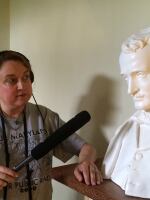If you visit the fourth floor of the Baltimore City Chief Medical Examiner’s office, you’ll see a series of what appear to be dollhouses. They feature fully furnished scenes complete with antique fixtures and everyday household items. They're inhabited by what, at first glance, appear to be regular dolls. At least, until you notice the dolls are laid out like dead bodies.
They’re known as the Nutshell Studies of Unexplained Death.
It's a collection of 18 miniature crime scene dioramas that's had a home in Baltimore since 1968. They were created in the 1930s and 40s as tools to train homicide detectives from around the world.
Their creator? Francis Glessner Lee, a millionairess who gave a lot of money to Harvard University to train doctors to become medical examiners. Back then, by the time medical examiners got to crime scenes they were contaminated.
Glessner Lee recognized the need to intervene earlier in the investigation. At the time, there was no formal training program for homicide detectives… so she created the Nutshell Studies to teach detectives to look, to observe, to pick out potentially meaningful evidence out a myriad of details.
Glessner Lee was obsessive about the dioramas – everything had to be just right. She hired a carpenter to construct each study, on a one inch to one foot scale. The doors had hinges and real locks. She sewed and knitted (with tiny straight pins) the clothes for figures. She created all the textiles and details, rolling tiny cigarettes with real tobacco and carving clothes pins out of wood scraps.

This attention to the slightest detail is what makes the dioramas such valuable training tools. Bruce Goldfarb, the executive assistant to the Chief Medical Examiner, serves as a de-facto curator of the collection. He notes that the evidence in the Nutshell Studies is often very subtle – because they contain so much detail that it’s entirely unclear what investigators are supposed to look at.
“Just as in real life,” says Goldfarb, “when you walk into somebody’s home and there is stuff all over the place, there’s magazines, and clutter, and things and clothes thrown around and whatnot so just like a real scene, you walk in here and it’s a moment, frozen in time. You arrive at the scene and where do you start? And what are you supposed to be looking at? So that’s part of the process, reserving judgment, keeping an open mind, and just looking as thoroughly as you can, at everything that may or may not be meaningful.”
The figures depicted in the Nutshell Studies -- women, mostly -- are not the sorts of people the wealthy Glessner Lee would have known in real life. Yet, she worked hard to get all of the details about the victim right, no matter where, or how, they lived.
One of the studies depicts a tableau of woman was in the bathtub, under a running tap, with her legs dangling out of the tub. It’s a fairly modest bathroom, with a commode in the corner entirely unlike any toilet Glessner Lee would have used in her privileged life. But she knew there would be a worn spot in the front from people standing there, so it's part of the diorama. She damaged the wall above a heating vent, as if it were real life. She made sure the boards beneath the sink were water-stained. Goldfarb says the water marks have no evidentiary use at all, but says something about the socioeconomic status of who the people who lived there were.
Indeed, much of what’s in the Nutshell Studies isn’t about what how the people depicted died, but about who those people were.

Francis Glessner Lee devoted a great deal of her family fortune to improving the methods of medical examiners and homicide detectives who serve all members of society, rich and poor, good, and bad. And perhaps most remarkably, the models are still very much in use today. Despite 3D software modeling, and virtual reality, there is something about visiting, and re-visiting the models, checking, and looking again, that is still a valuable learning experience, and something that can’t be done any other way.
The Nutshell Studies are still used as teaching tools today. As Bruce Goldfarb says: “this is a classroom, not a museum. I tell people this is 1930s virtual reality… and they’re still as meaningful and useful as they were in the 1930s.”
A visit to the nutshells yielded many surprises, but perhaps one of the most unexpected was a strange feeling of comfort. Homicide detectives, forensic investigators, medical examiners, really want to solve unexplained deaths. In a sense, they speak for the dead, just as Francis Glessner Lee tried to with the gift of her models all those years ago. Goldfarb says “no matter who you are, if you die in the state (of Maryland), you’re going to have the same investigation done with the same processes by the same people every time. Every single person is treated the same and every person, every death is meaningful, every death matters, and everybody is treated the same when they come through here.”
Bruce Goldfarb is giving a lecture and slide show presentation on the history and importance of the Nutshells on Wednesday, July 13th at 7pm at Med Chi, the Maryland State Medical Society. More information about the event is here.



